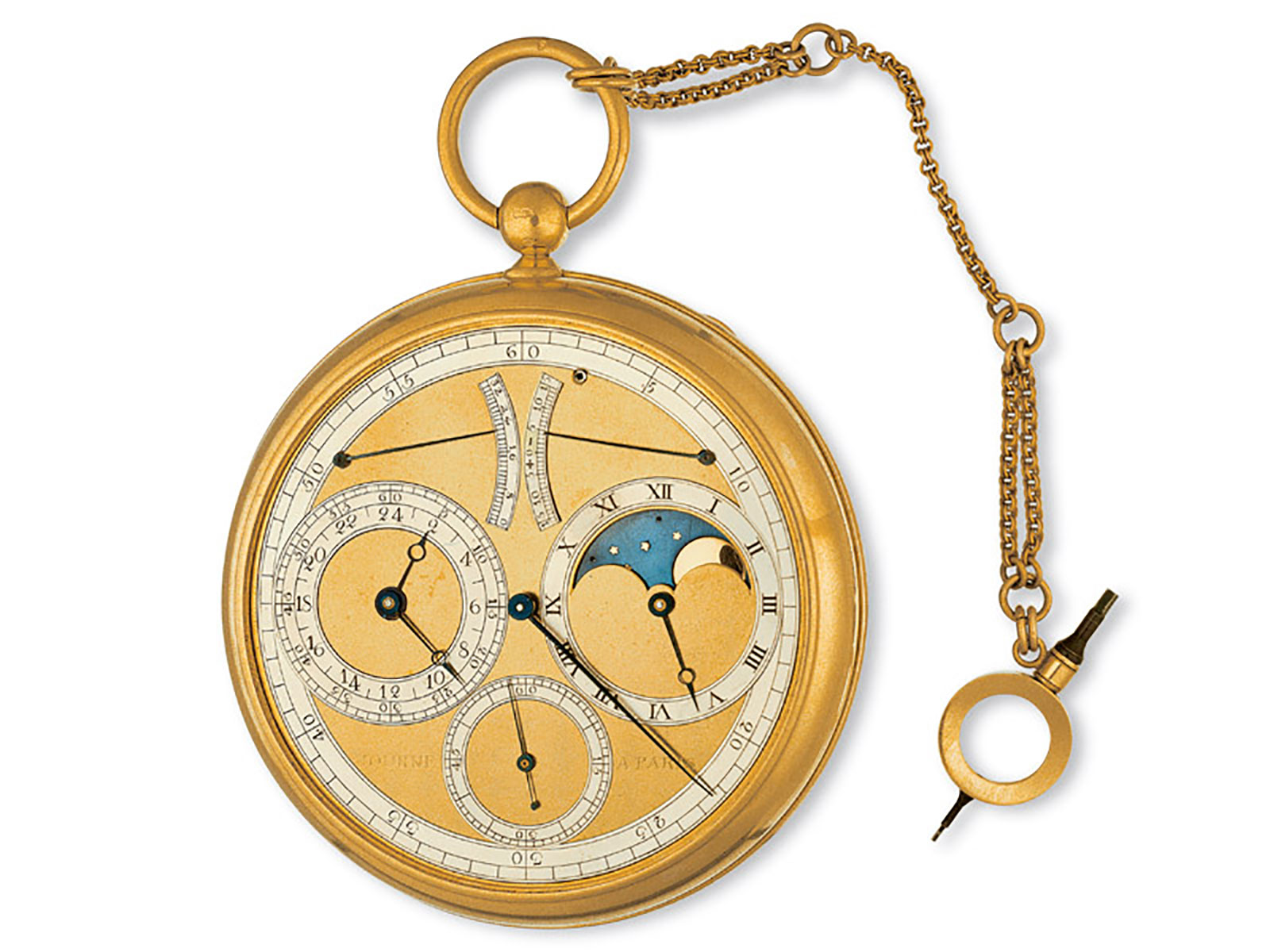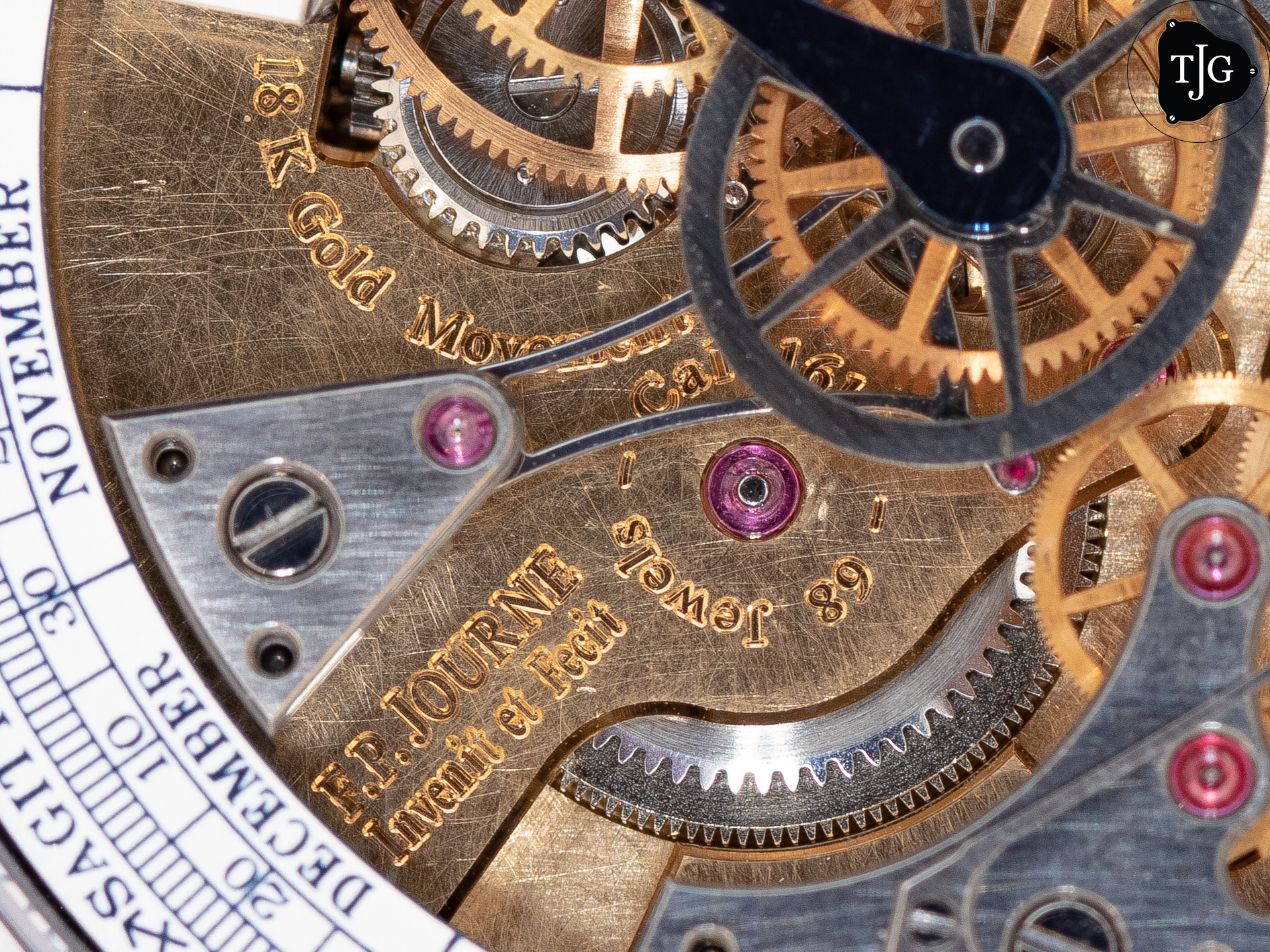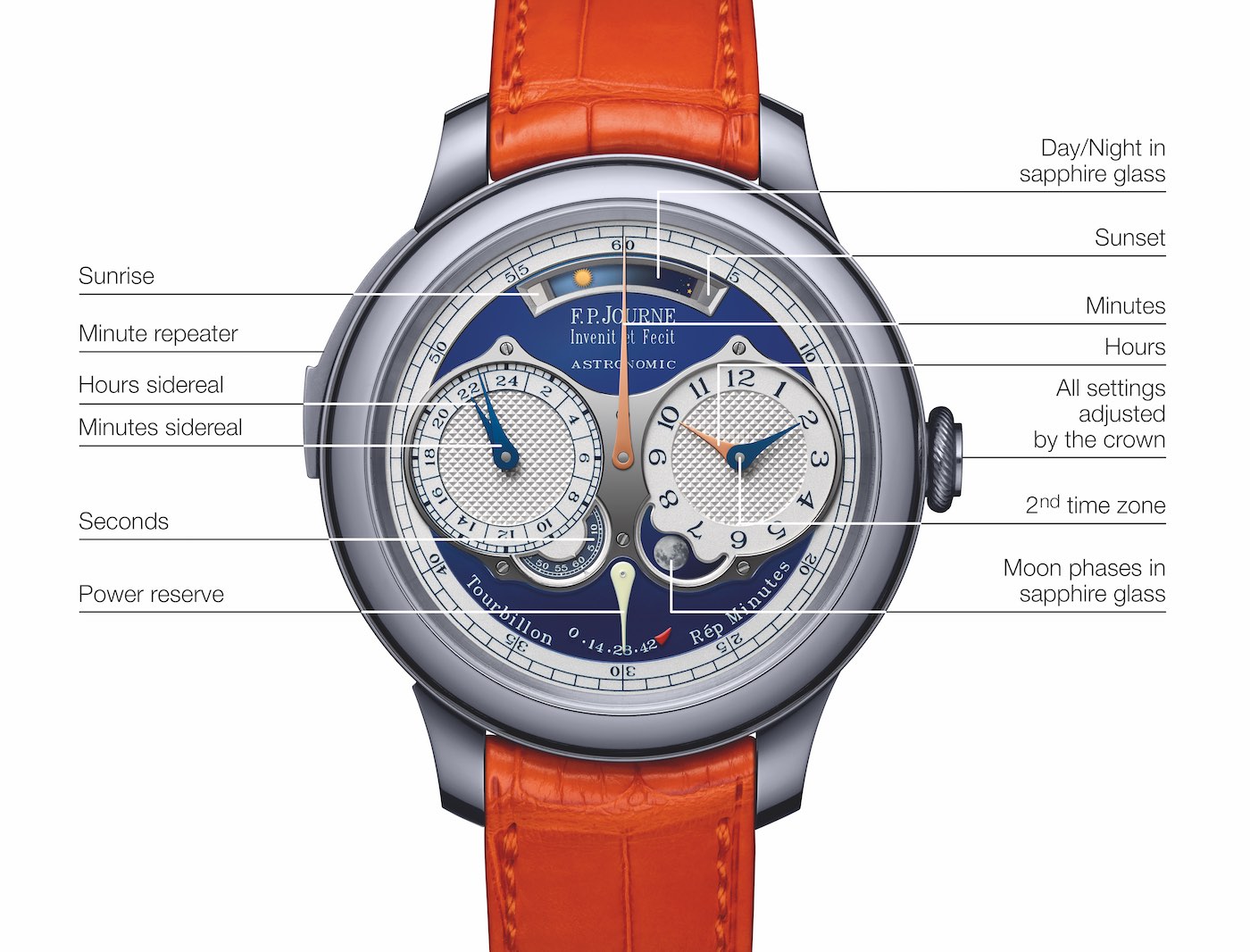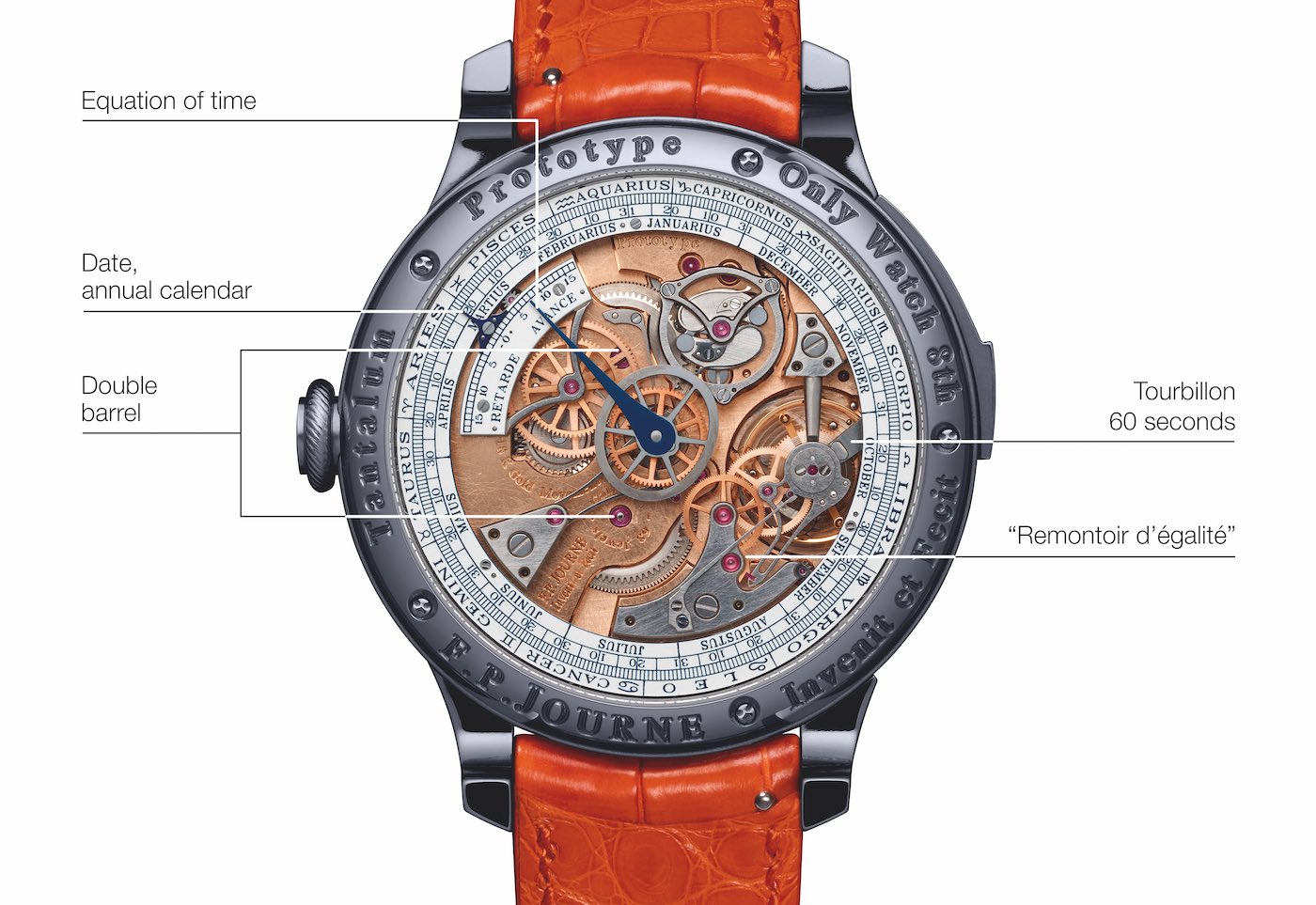It’s been three months since the unveiling of the 2019 Only Watch catalogue and with it, F.P.Journe’s highly anticipated grand complication timepiece, the Astronomic Blue.
The Astronomic had been the topic of much tease among close F.P.Journe enthusiasts for well over the past five years, but had only gained heavy speculation among the larger watch community with the official brand announcement of the replacement of the Sonnerie Souveraine, just over one year ago.
Since the announcement, the question that popped to mind was, “What could possibly be worthy of replacing the Sonnerie Souveraine?”, to which I followed up for an even bigger hint from Mr. Journe last year.
Finally, the replacement and long-awaited project comes to life and today, we dig into it a bit more in detail.
Inspiration
It all began roughly 15 years ago when François-Paul Journe was on his way to Marseilles for the holidays to visit his family. His son, Charles, was only a young adolescent at the time and had promised to design a watch so that his father, the master watchmaker, could evaluate it. To François-Paul’s surprise, when he had arrived at his family’s home, he found that Charles was quite upset and had thrown away the sketch thinking it would never be good enough for a “real” watchmaker, which he wasn’t. Behind the trash can, François-Paul found the sketch of a sort of astronomic dial, that depicted an aperture of the sun and the moon, and inspiration for the change between the day and night. This sketch is what lit the spark in Mr. Journe’s mind and inspired him to re-imagine an astronomic timepiece, something he had done once before in 1987 for his sixth timepiece.

Part of a private collection.
Project Launch
One would imagine that once the idea for a watch comes to mind, it begins to find its way onto a sketch almost immediately. Such a thought is often misleading since most of the time spent during the development of a timepiece is in imagining it and mentally developing it. In the case of the Astronomic, it took François-Paul Journe five years just to develop the watch in his head, thinking of all the complications, the dial layout, the challenges, nearly everything just to make sure that in theory, it could actually work and make sense. He says he started to think about it back in 2005, one year prior to launching the Sonnerie Souveraine, and that he spent a considerable amount of time just thinking of how the dial should look like.
Once he covered the dial aspect, he started to think of constructing the movement which would bring life to the watch (this is typically how François-Paul works, dial followed by movement). He thought of using several different calibers that he had developed as a base for the construction of the Astronomic but found that nothing would work. The movement was so complex and demanding that it required a completely unique development from scratch, dedicated specifically to this grand complication.
Against his own philosophy
I was one of the very few people who actually enjoyed the previous version of the official F.P.Journe website. As soon as you got onto the site you had an entrance page with a layout of all the models encircling the brand’s logo. Why did I like it so much? Because it made me realize something really important when it came to F.P.Journe’s watchmaking philosophy. One Watch = One Complication.
To François-Paul, a complication is a bit like attaching a trailer to a car. The more complications you attach to a movement, the less efficient and precise that movement becomes and so, the philosophy has always been to develop one complication but make it the most efficient complication both in terms of legibility on the dial, and its performance within the movement.
Of course, that led to two problems with the first being that of critics. Word picked up that this so-called “Master Watchmaker” couldn’t even compete among the grand complication likes of his competition.
Second, the problem for François-Paul was how could he possibly mount several complications within a movement and yet still promise its chronometric performance, its ease of use, and most importantly its uncluttered dial. This bigger obstacle is what took the watchmaker 10 years to solve.
The Astronomic
In total, the Astronomic delivers 18 “features” split between the dial, caseback, and movement. It is very difficult for me to call all 18 complications, or functions, since in some cases they don’t really function but rather add something to the movement’s construction design which ultimately benefits the precision. So for the purposes of this article, and all my discussions regarding this timepiece, I prefer to stick to the term features. We listed all 18 in the introductory article back in June, so this time we can dwell a bit further in.
To start, for all that goes on with this dial, it is remarkably legible. First, the time is denoted by the golden hour hand on the right subdial, along with the larger minute hand, also golden, but going around the entire dial track. The seconds is denoted by the dead seconds disc, which is a natural dead seconds, a result of the remontoir d’égalité. Further on the right subdial is an additional timezone hand, in blue.
The left subdial is dedicated to sidereal time, which is time measured based on the earth’s rotation relative to the “fixed” stars, not the sun. Basically, if you are using your telescope, you’ll want to know what this is and also how to use it as an essential astronomer’s tool.

Located at the top-center of the dial is the day/night indicator. A large disc alternating with images of the sun and stars makes a full rotation around the exterior portions of the dial to display this feature.
Integrated into the indicator is a sunrise/sunset function. Unusual to other astronomic timepieces that actually have separate subdials to display the sunrise/sunset times, often by displaying them down to the hour and minutes, F.P.Journe opted for the use of a moving aperture.

The aperture contracts and expands to shorten/lengthen the display of the day/night indicator. François-Paul mentions that each owner can specify to which city they would like the indicator to be set to, with certain exceptions to the northern-most cities of the globe, which have tremendously long/short days and nights that make it mechanically impossible to calibrate into the watch.
It’s quite a clever and pretty way to integrate the two functions together but for those who are looking for exact timings of the sunrise/sunset function, this might not meet their specific desires. I would call this a more elegant approach however.

Two other complications on the dial are the moonphase and the power reserve indicator. I was quite worried how the moonphase would end up looking on this dial since in the past, I was never an aesthetic fan of the complication. F.P.Journe uses sapphire disks for the moonphase display which can be an absolute pain to assemble and not quite legible, as covered here, but François-Paul really pulled it off on the Astronomic. The picture of the moon is based off of an actual NASA photo of the moon, which means you get a crisp display that you can read under any light. I am not sure how F.P.Journe managed to pull this one off but it looks really cool and I hope they adapt it to their other moonphase timepieces.
Finally, the power reserve system is an F.P.Journe standard, patented since its creation for the Chronomètre Souverain in 2005.
The Astronomic is the first time François-Paul introduces a double-sided timepiece into the F.P.Journe collection. Featured on the caseback is an annual calendar with a Zodiac ring, adapted from his Octa Zodiaque in 2003. I will admit, it is not the most legible of date displays but I am not one to personally be bothered by it and being on the caseback, I’d imagine it isn’t meant to be used as a ‘quick glance’ date either. I would go to further to assume that the choice for an annual calendar over a perpetual calendar had to do with keeping the function of this watch rather simple to set, without any additional tools or pushers on the case, which we will dwell into a bit further down.
Long awaited and demanded by his collectors, also featured on the caseback is one of my favorite complications, the Equation of Time (EOT). In short, the EOT is the difference between Mean time and Solar time, or better explained as the length of a given day according to the sun’s position, not by our definition of 24-hour long days. The EOT is indicated by a large blued hand pivoting from the center, indicating the minutes longer or shorter than 24 hours.

Aside from the astronomic side of complications, Mr. Journe has also added a 60-second tourbillon and a minute repeater, which uses his patented flat gongs. I opted not to record the sound of the repeater and perhaps that was a mistake on my part. My initial thought was that since the Astronomic Blue, which I handled, was cased in Tantalum, it would reflect poorly on the final sound of the Astronomic Grand Complication, which like all chiming watches F.P.Journe produces, would be in steel. That said, I must note that the lever on the side of the case was softer and smoother than silky butter. In fact, the first time I slid the lever, I couldn’t even pay attention to the sound because I was astonished with how smooth the slider felt, absolutely frictionless. That aside, the sound wasn’t terrible but quite muted, evidently from the case material.
Keeping it Precise
As mentioned earlier, François-Paul Journe is openly against the use of adding several complications onto a single movement, claiming it is detrimental to the precision of a timepiece. He further went on to break the myth of tourbillons, going against the industry grain in saying that a tourbillon does more damage to the precision of any timepiece than good; once noting that the only thing that would make his own Tourbillon Souverain more performant would be to completely remove the tourbillon.
So, the question remains, why is this timepiece any different? The answer lies within the construction of the movement itself and one added mechanism that changes everything.
First, the use of a double-barrel layout, which he uses in his Chronomètre Souverain/Bleu and notably in his Chronomètre Optimum. The setup does not aim to prolong the watch’s autonomy but instead to provide a stable source of energy from the mainsprings. Essentially, the high pressure on the main gear is split into two, making the flow much more consistent from the source.
Next, and the true marvel, the use of the remontoir d’égalité, controlling the flow of energy to the escapement so that it is consistent and uninterrupted. When I asked François-Paul how this timepiece could still meet his chronometric standards, he simply replied, “I have a remontoir d’égalité, it controls all the energy related to the timekeeping.”

The Single Crown
If there is one nuisance I seem to have with a complicated watch, it is when there are certain complications to setting it. If you research almost any grand complication, or sometimes even complete calendars, you will almost always find recessed pushers on the case, which require a pin (or a dreadful toothpick) to set. Furthermore, there are always danger zones stamped all over the manual cautioning against setting the watch during certain hours, or you risk seriously damaging the movement. All in, that is a lot to go through but it has somewhat become a sort of norm, or rather to say expected.
The goal of the Astronomic was to rid of all these complexities by means of a single crown. The case remains clean and undisturbed, and everything is adjusted from a single, normal crown. That is innovation and as far as I could tell, never before done for a watch of this scale with this many complexities. Mr. Journe really had to crack his head with this one!
Dimensions and Parts
The Astronomic measures 44 mm in diameter and 13.75 mm in height which is again, impressive for what it is, though not necessarily slim; making it roughly 1 mm thicker than the Sonnerie Souveraine it succeeds. Regarding the number of components, 758 parts make up the movement alone, roughly double that of the Sonnerie Souveraine. The Manufacture refuses to publish the total number of components required for casing as this number will differ between the Tantalum prototype and the Steel production cases.

A Prototype
To fully understand this prototype, one must understand how François-Paul works on his watches. Everything starts off as an idea that he will later sketch out. Once he is satisfied with the sketches, he then builds the watch using CAD on a computer, designing it in-detail from the ground up. Upon completion of his CAD design, he will then send requests for the components by having his tech team adapt his sketches into manufacturing plans (up to 900 plans for a full watch). During this early prototyping phase, which can be quite long, all work is done on brass components. Logically, the movements have no reason to function as prototypes and so the parts can be discarded, making it rather expensive should they be in 18K Gold.
When François-Paul finally reaches a fully functioning brass movement, he will then make the first prototype using the brand’s signature gold movements. Ultimately, when this gold prototype comes to life, one could say that the project is finally completed.
For Only Watch 2019, F.P.Journe has cased up this first gold prototype movement in Tantalum with a chrome blue dial, alike the previous Only Watch entries. In being a prototype, the movement is raw. There is no clean or polished way to write this but this movement has not passed through any finishing department at all.

I remember the first time I saw this timepiece and I immediately questioned if François-Paul was going to offer this watch as is, or at least finish it. He explained, “It’s a prototype. That’s how it will look like. For those interested in bidding on it, they will be bidding on a prototype. For those wanting it to be finished, I recommend waiting for the production pieces which will be finished.”


The decision to offer an unfinished watch for a charity auction has created some controversy but I would think for someone interested in purchasing a rare prototype of an F.P.Journe grand complication, finishing would be the least of their concerns.

Final Thoughts
The Astronomic had been the talk of the F.P.Journe club of collectors for quite some time and when unveiled, it created the exact ‘boom’ moment one would expect. Of course, one could find certain inconsistencies with it if they really wanted to but all in, I think the timepiece does what it does in the best way possible and certainly proves that a multi-complication doesn’t need to be the size of a hockey puck, require 30 minutes to set, and brings a cluttered dial that makes reading anything impossible.
The Astronomic Prototype will hit the auction on November 9th with an estimate between $300,000 – $600,000, which I think is quite a low estimate, although inviting. Only after the auction will F.P.Journe start taking orders for the Astronomic production model, of which the price is currently undisclosed to protect the auction price, which bidding collectors will determine.



2 responses to “In-Depth: The F.P.Journe Astronomic Blue Prototype”
What is really interesting here is the prototype calibre 1619 encased in this tantalum protective box. And yes, this is clearly Journe s most complex movement ever, and probably one of the most complex movements recently made by the Swiss industry, with no fewer than 18 complications. Dial-side, the F.P. Journe Astronomic Blue displays the time (including dead-beat seconds), the sidereal time, a second time-zone, a power reserve, a day-night indicator, the moon phases and the sunrise and sunset indications. Not the simplest watch to read, but still impressively well organized. The classic chrome blue background with a guilloche silver dial is always a thing of beauty.
This is one for the history books. Thanks for the informative article.